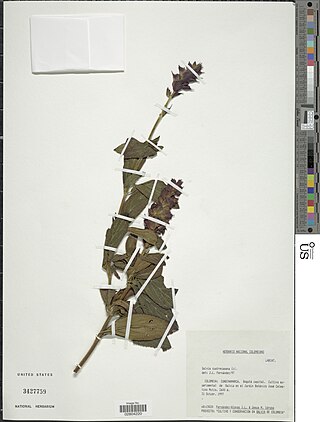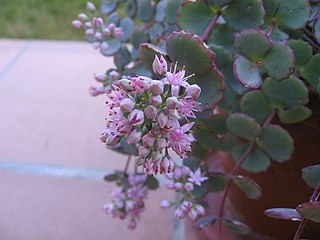
Sedum is a large genus of flowering plants in the family Crassulaceae, members of which are commonly known as stonecrops. The genus has been described as containing up to 600 species, subsequently reduced to 400–500. They are leaf succulents found primarily in the Northern Hemisphere, but extending into the southern hemisphere in Africa and South America. The plants vary from annual and creeping herbs to shrubs. The plants have water-storing leaves. The flowers usually have five petals, seldom four or six. There are typically twice as many stamens as petals. Various species formerly classified as Sedum are now in the segregate genera Hylotelephium and Rhodiola.

Sedum acre, commonly known as the goldmoss stonecrop, mossy stonecrop, goldmoss sedum, biting stonecrop, and wallpepper, is a perennial flowering plant in the family Crassulaceae. It is native to Europe, northern and western Asia and North Africa, but is also naturalised in North America, Japan, and New Zealand.

Petrosedum rupestre, also known as reflexed stonecrop, Jenny's stonecrop, blue stonecrop, stone orpine, prick-madam and trip-madam, is a species of perennial succulent flowering plant in the family Crassulaceae, native to northern, central, and southern Europe.

Phedimus spurius, the Caucasian stonecrop or two-row stonecrop, is a species of flowering plant in the family Crassulaceae. It is still widely listed in the literature as Sedum spurium.

Hylotelephium spectabile is a species of flowering plant in the stonecrop family Crassulaceae, native to China and Korea. Its common names include showy stonecrop, iceplant, and butterfly stonecrop.

Hylotelephium cauticola, the cliff stonecrop, syn. Sedum cauticola, is a species of flowering plant in the family Crassulaceae, native to Hokkaido, Japan. Growing to 8 cm (3 in) tall by 30 cm (12 in) wide, it is a carpet-forming succulent perennial with trailing stems of pink-tinged grey-green round leaves, and purplish pink star-shaped flowers in autumn.

Salvia shannonii is a tender perennial native to the Mexican state of Chiapas, and to Guatemala, El Salvador, and Honduras, growing in or near pine forests at approximately 3,000–5,000 feet elevation. Its native habitat receives regular moisture in the form of fog, rain, and streams, with mild temperatures that stay above freezing.
Galium hardhamiae is a species of flowering plant in the coffee family Rubiaceae, known by the common name Hardham's bedstraw. The scientific name may be misspelled Galium hardhamae. It is endemic to the Santa Lucia Range of southern Monterey County and northern San Luis Obispo County in California. It is a member of the serpentine soils flora in these coastal mountains. This is a perennial herb forming mats or clumps of stems no more than 30 centimeters long. The stems have many whorls of six fleshy green leaves, each leaf just 1 to 3 millimeters long. The inflorescences, clusters of yellow-green to pinkish flowers, appear in leaf axils.

Vriesea wawrana is a plant species in the genus Vriesea. This species is endemic to Brazil.

Phedimus is a genus of the succulent family Crassulaceae, with about 18 species, distributed in eastern Europe and Asia. The genus is described with two subgenera, but one of these is also recognized as a separate genus, Aizopsis. Phedimus kamtschaticus is widely grown as an ornamental ground cover and has gained the Royal Horticultural Society's Award of Garden Merit.

Salvia cuatrecasasiana, first described as Salvia cuatrecasana, is a perennial shrub that is endemic to a few small areas in Colombia, growing at 2,800 to 3,500 m elevation on roadsides, streamsides, and disturbed areas.

Sedum lanceolatum is a species of flowering plant in the stonecrop family known by the common names lanceleaf stonecrop and spearleaf stonecrop.

Sedum spathulifolium is a species of flowering plant in the family Crassulaceae known by the common names broadleaf stonecrop, yellow stonecrop, and spoon-leaved stonecrop. An evergreen perennial, it is native to western North America from British Columbia to southern California, where it can be found often in shade in many types of rocky habitat in coastal and inland hills and mountains.

Hylotelephium sieboldii, the October stonecrop, Siebold's stonecrop, Siebold's sedum or October daphne, is a species of flowering plant in the family Crassulaceae, native to Japan. Growing to 10 cm (4 in) high by 20 cm (8 in) wide, this trailing deciduous perennial produces its round glaucous leaves in whorls of 3 around the delicate stems. The hot-pink flowers appear in autumn (fall).

Sedum adolphi, the coppertone stonecrop or golden Sedum, is a species of succulent plant in the family Crassulaceae. It is native to Mexico, where it grows in rocky terrain and on cliff faces. It has also become naturalized in Sicily and the Canary Islands. It is known for its bright orange-copper leaves and white flowers that bloom in the spring.
Zeuxine rolfeana is a deciduous terrestrial orchid belonging to the subfamily Orchidoideae. It is found in South Andaman Island. Its name is also spelt Zeuxine rolfiana.

Sedum hispanicum, the Spanish stonecrop, is a species of flowering plant in the family Crassulaceae.

Acis ionica is a species of flowering plant in the family Amaryllidaceae, native from south-western Albania to western Greece. It was initially confused with what is now Acis valentina, a species found in Spain near Valencia.

Phedimus kamtschaticus, the orange stonecrop, is a species of flowering plant in the family Crassulaceae. It is a low-growing herbaceous perennial native to eastern Russia, northeastern China, Korea, and Japan. The species is commonly grown as an ornamental plant, and has escaped cultivation in Europe and the US.

Phedimus aizoon is a species of succulent herbaceous perennial plant in the family Crassulaceae. It is native to China, the Russian Far East, Korea, Japan, Mongolia, and Kazakhstan, where it grows on rugged terrain. It is commonly used as an ornamental plant, but is also edible.

















